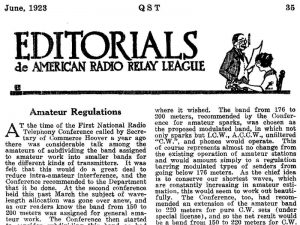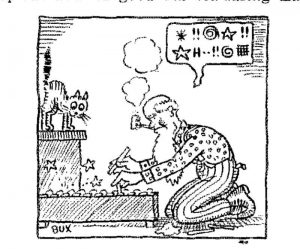
FRIDAY NIGHT, FEB. 3, 2017
I was browsing some nearly century-old QST magazines a couple of days ago and ran across an interesting period of Amateur Radio history when “Old Man” spark and the “New Kid on the Block” continuous wave (CW) were competing for the same bandwidth (as well as the hearts and minds of the Amateur community).
And as you might expect, in 1922-23, the continued use of spark was creating growing problems with interference among the growing number of  commercial stations and a growing group of non-hams referred to as the “BCLs” — broadcast listeners.
commercial stations and a growing group of non-hams referred to as the “BCLs” — broadcast listeners.
Spark stations were slowly being replaced on the commercial side by CW; the Amateur ranks were also moving in that direction — for the same reason. A reasonably pure CW signal did not create the interference problems that spark transmitters or modulated CW schemes created, nor did they consume large amounts of bandwidth. But the real problem facing Amateurs were not “the commercials” but the Ma and Pa radio owners, who were growing in number and raising hell about interference from (in QST’s words) “those damned Amateurs.”
The ARRL recognized the Amateur community needed to take action to avoid punitive action by the government in regard to solving interference issues. In 1922, the ARRL put forth a plan to establish voluntary quiet hours — spark stations, modulated CW stations and other interference-causing “wide band” modes operated by Amateurs would cease transmission between 7:30-10:30 p.m. so the “BCLs” could enjoy their receiving sets. Through the pages of QST, the League promoted voluntary cooperation with the quiet hours plan, acknowledging that if Amateurs did not self-police, the government will likely step in and take sweeping action that the ham community would not enjoy.
The Commerce Department wound up issuing regulations the following summer (1923) that made the voluntary quiet period mandatory — from 8-10:30 p.m. QST squarely placed the blame for the new regulations on those young squirts and high-strung, RF-addled ginks who failed to follow the League’s voluntary plan. Quiet hours also prohibited Amateurs from transmitting during Sunday mornings while local church services were under way.
After learning that quiet hours were likely to become part of a new set of regulations, the ARRL lobbied to allow stations using “pure DC CW” to operate without quiet hours, given the fact that those stations were unlikely to create interference with commercials or the BCLs. Their lobbying was for naught, however; the government applied quiet hours in its regs to all licensees and stations.
With the new 1923 regulations, the government also created the “Amateur Extra First Grade” license. This new ticket required 20 wpm code speed (receive and transmit), passing a special test and two years of experience as a licensed Amateur.
One interesting note … in trying to answer the question “When did spark transmitter use end?” I found that spark was still allowed in maritime service until about 1940, and then after that for a time permitted on the 500 kHz maritime distress frequency.
In September 1924, the 1923 regs were set aside and a whole new set of regulations were issued by the Department of Commerce and published in QST. For the first time, U.S. Amateurs received official access to the shortwave bands — 80, 40, 20 and 5-meter bands, in addition to the existing allocation between 150 to 200 meters. Quiet hours were dropped by the new regs — which also prohibited the use of “Old Man Spark” on the new shortwave bands. If the Amateur station created interference, then quiet hours could be imposed on a case-by-case basis. And as one would expect, QST published its first articles on how to operate on 80,40 and 20-meters with the same issue in which the new regs were introduced.

One of the QSTs that discusses regulation changes features a column by “The Old Man,” “Rotten Rectifiers.” He mentioned the imposed quiet hours, and questions why he must observe quiet hours when his signal is inaudible in 99.99999999 percent of the continental United States. Love me some “Old Man”-isms, hi hi.
EL STINKO PROPAGATION. I’ve been trying to make sure I get in the shack regularly for the Georgia CW net; and I have been doing well at making it to the shack on time; the only problem is that propagation didn’t get the message to appear on time. A couple of nights ago, I couldn’t hear the NCS (located in Eastern Kentucky, fairly close to me as the propagation crow files); I also missed hearing the majority of stations in northern Georgia. The stations I copied best were the furthest away (go figure). Tonight the propagation was slightly better; and took a deep fade about midway through the net. I was determined to check in, even if I couldn’t hear the NCS again. It was a relief that this evening the band was much improved.
COMPUTER-GENERATED HASH. If it sounds like I’ve created a food replicator in my Dell XPS 8700, think again. No, I’ve been plagued by hash the computer power supply has generaeted, particularly on 75 and 80 meters. The issue appears to be related to a lack of a common ground for the transceiver and computer; as you might expect, the wiring in this part of our 1921 farm house is not three-wire wiring.
After the weather turned cold, I set aside plans to really troubleshoot and eliminate the hash; so far I am managing it ok; I replaced the first-generation ICOM IC-706 that was next to my chair in the library with an ICOM IC-746. The 746’s noise blanker does a great job eliminating most of the effect of the power supply hash; at least it allows me to listen and operate the computer at the same time without pulling out my hair.
BUG-O-MY-HEART. After several weeks of use, I have set aside the 100th Anniversary Vibroplex bug and have put others in my collection to use. Tonight I used one of my Les Logan Speed-X 500 bugs. Others are awaiting their turns as well.
That’s it for tonight … HV GRT WKEND 73 ES CUL DE KY4Z SK dit dit …
-30-
